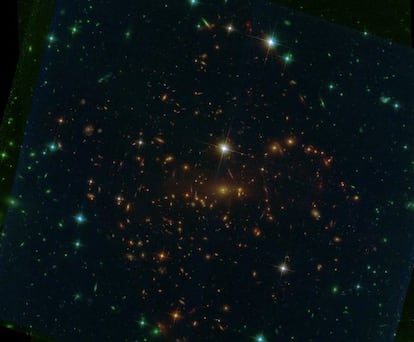If anyone doubted the quality of the photos that the James Webb
Space Telescope was going to offer us
, it is enough to compare the one presented on Monday by the president of the United States, Joe Biden, with another of the same area of the sky obtained years ago by the
Hubble
.
It is true that they are two very different images: The one from
Hubble
was obtained with visible light (and a narrow range of infrared);
that of the
Webb
has been made essentially taking advantage of the near infrared.
The number of galaxies, the detail that can be seen in them is simply overwhelming.
To interpret the content of the photo it is necessary to consider that the vast majority of the bright points are not stars, but galaxies;
swarms of millions and millions of suns, which we see as they were not yesterday, but billions of years ago, when the Earth did not yet exist.
Telescopes are authentic time machines that show us not today but the past.
It is likely that today many of the bodies we see in that photo no longer exist.
More information
The 'James Webb' telescope reveals thousands of galaxies in the deep universe, in its first full color image
The sense of scale is also surprising.
The field covered by the photo is tiny, as Biden himself was explained at the presentation, barely the size of a grain of sand held between two fingers at arm's length.
It corresponds to a segment of the Scuptor constellation, only visible from the southern hemisphere.
The same image of SMACS 0723, taken by the 'Hubble'.NASA
In the center of the photo arcs of light can be seen that seem to mark the outline of a huge bubble.
Each one is a warped galaxy because, to reach Earth, its light has had to pass through a gravitational lens, almost like a fisheye lens.
It is the result of the gravity of an intervening galaxy, closer to us, which deflects and distorts the images of objects that are much further away.
Einstein already predicted this effect, although he doubted that it would ever be observed due to the technical difficulties involved.
In just 100 years, the new telescopes have made his dream come true.
The colors in the image are synthetic.
Telescopes record their images in black and white, through colored filters.
Combining several shots of the same field, obtained at different wavelengths, it is possible to recompose the appearance they would have if we could see them with our eyes... although the color palette will always be, in some way, artificial, since much of the light, in the infrared, it is invisible.
In that case, six filters have been used: two in different shades of blue, two in green and two in red.
To collect enough light,
Webb
's mirror had to remain pointed at the same region of the sky for more than 12 hours.
As a comparison, the Hubble ultra-deep field took more than 200 hours, spread over numerous sessions over several months, since its movement around the Earth did not allow it to keep it pointed continuously;
the
Webb
, anchored around Lagrange point 2, does not suffer from this limitation.
Apart from the enormous capacity to capture photons that its six and a half meter mirror gives it.
In any case, this has been a first photo to demonstrate the possibilities of the telescope.
In the future, no doubt, we will see other attempts to go even deeper into space, in search of the holy grail of the
Webb
: the first galaxies whose light illuminated the Universe.
You can follow
MATERIA
on
,
and
, or sign up here to receive
our weekly newsletter
.

